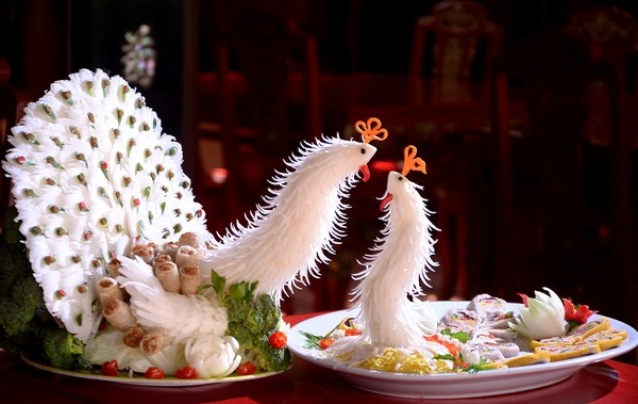Hue Royal food dishes are the only royal dishes in Vietnam tobe clearly recorded in old Vietnamese encyclopaedia and have strictrules regarding preparation. They are still preserved by royaldescendants or descendants of royal chefs, although some elements of themodern-day versions may not be original.

Tet (Lunar New Year) was held in high regard by the Nguyen Dynastyemperors, who considered it the starting point of new opportunities forthe Kingdom so it had to be joyfully celebrated, in addition toworshipping and presenting offerings to the ancestors and gods.
Just like dishes for ordinary people, dishes for the royal familieswere prepared long before Tet. Foods that could be stored over a longperiod of time were prepared in the traditional way, with someimprovements being made by adding local touches popular in the oldcitadel of Hue. The emperors and the royal families had their ownfavourite dishes, which are explained in the encyclopaedia, togetherwith offerings to the ancestors and gods.

In the encyclopaedia called Kham Dinh Dai Nam, Volume 237, by QuangLoc Tu 1 (Chapter 14), Page 270-271, regarding dishes for a party, it iswritten that Emperor Tu Duc issued a set of regulations in 1849 onofferings during the annual three-day Tet holiday.
There were clear instructions on where first-class food dishes wereto be offered, where second-class food dishes were to be offered andwhere third-class food dishes were to offered, and how many trays offood were offered at each table, with 161 flavours being the maximumnumber for a tray of first-, second- and third-class food dishes.
The dishes called ngoc soan included smoked foods, cooked foods,fresh vegetables and shrimps and crabs, and were displayed on 30 dishes.
The dishes called qui, which were intended for the emperor or seniormembers of the royal families, included 50 flavours – chicken, duck,boiled pork, roast pork, wood ear mushrooms, enoki mushrooms, fins,eels, turtles and different kinds of cakes such as banh chung, banh day,banh que, banh te dieu, banh hoang tinh, banh dua, and banh gao neptrang.
Breakfast dishes included fried duck, fried pork, fried shrimps, boiled pork, and 12 flavours.
Dishes as offerings at pagodas like Giac Hoang Pagoda consisted offive trays of first-class dishes, 17 trays of second-class dishes, fivetrays of first-class vegetarian dishes, and 17 trays of second-classvegetarian dishes. At Dieu De Pagoda, dishes as offerings consisted of13 first-class dishes and 45 second-class vegetarian dishes.
During the reign of Emperor Minh Mang (1791 -1841) the Hue Royal fooddishes were well-organised with clear regulations. There were differentkinds of dishes during the reign of each emperor, however, because oftheir different tastes and favourites.
During the reign of Emperor Dong Khanh, for example, the royalfamilies began to use chopsticks made from a very beautiful light woodcalled podocarpus fleuryi hickel, while during the reign of Emperor KhaiDinh western spirits began to be drunk, and royal dishes began to havesignificant influences on the dishes of ordinary people, especiallyduring the Tet holidays.
Only banh chung was chosen as an offering, yet many dishes,including different kinds of cakes and different kinds of meat loafs,were served to the emperors and royal families. Emperor Bao Dai’sfavourite dishes included slices of boiled pork served with mungbean sprout pickles, shrimp paste, green bananas, star fruit, andcucumbers, as well as mustard green rolls and shrimp pickle rolls.
Most of the ingredients for the offerings to ancestors and godsduring Tet and other offering rites recorded in the encyclopaedia werepresented to the emperors by provinces around the country, and thoseingredients were specialities of the best quality form the provinces andhad to be presented to the emperor well before they were needed forevents.
For instance, rice and fruit came from Thua Thien, fins and turtlesfrom Gia Dinh (in then Saigon), mangoes from Phu Yen, limes from BinhDinh or Quang Nam, lanzones from Quang Nam, sweet oranges from Thanh Hoaand Hai Duong, watermelons from Quang Binh, polygonatum kingianum,soybean paste and mulberry wine from Quang Binh, and coconuts from VinhLong and Dinh Tuong (now Tien Giang) provinces.
In addition to the things presented to the emperor as offerings tothe ancestors and gods, the ingredients presented to the emperor and theroyal families during Tet were strictly compliant to certain rules.Black buffalo, goats and pigs were presented by residents from the threedistricts of Huong Tra, Quang Dien and Phu Van in Thua Thien province.The animals were taken good care of by residents and were presented to ateam in charge of slaughtering them in the required way.
Wine as an offering was of great importance, so it had to be chosenfrom the best kind of rice and had to be clean, from the ingredients tothe final product when sealed in pots, and a group of officers wereresponsible for everything. Medicinal wines like Emperor Minh Manh winehad to be processed with great care.
In general, royal cuisine ensured that the ingredients and fooddishes were of the best quality and hygiene from the stage of growing tothe stage of processing. All steps had to be strictly supervised andsevere penalties, including beheading, were imposed if preparation wasnot done properly. The dishes also had to be tested for poison beforethey were presented to the emperors.
The Guide
Fit for a King
#vietnamtravelnews #vntravelnews #vietnamnews #traveltovietnam #vietnamtravel #vietnamtour
Vietnam Travel News - Explore what"s happening around Vietnam.
www.vntravelnews.com
www.facebook.com/vntravelnews
www.twitter.com/vnntravelnews
www.pinterest.com/vntravelnews/
https://plus.google.com/+Vntravelnewscentre/
Không có nhận xét nào:
Đăng nhận xét